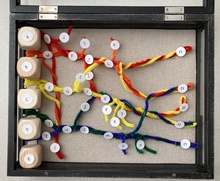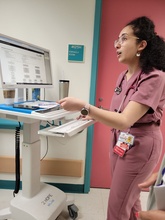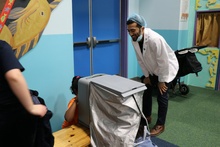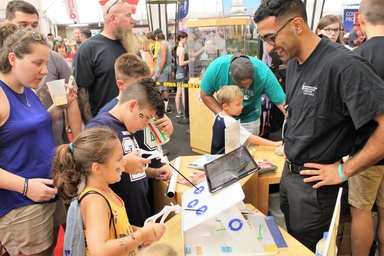Mariam Mansour (23MD) knew she was interested in the Carver College of Medicine Teaching Distinction Track before she was even admitted to the college. She inherited a passion for education from her mom, a former middle school science teacher, and loved being a Sunday school teacher at her church from a young age.
“I remember thinking on interview day, ‘This is what I would do if I came here,’” she says. “Not every medical school had something like that.”
Mansour especially loved tutoring her classmates on anatomy beginning in high school, and she continued to do so throughout medical school. She has found that helping other students with tough concepts solidifies her own learning, too.
“In the anatomy lab, it’s not just memorization. There’s a little bit of an art to it,” she says. “When you are looking at a question in a practical exam and you have no idea what’s going on, what tips can help you approach that situation?”

She collaborated with Marc Pizzimenti, PhD, MA, BEd, to develop learning modules for first-year students studying the brachial plexus. In one module, Mansour used pipe cleaners to build a 3D model of the anatomical structure. She then outlined a step-by-step process that walked students through making the model themselves, identifying its component parts, understanding the structures’ connections to other body systems, and connecting the knowledge to its clinical applications through case vignettes.

Now a resident physician in pediatrics at Advocate Children’s Hospital in Oak Lawn, Illinois, Mansour often finds herself in the role of teacher for medical students on rotation.
“My experience teaching in med school and my experience with the Teaching Distinction Track set me up for success,” Mansour says. “It's always in the back of my head to be teaching the med students. I tell them to set goals, and I tell them my own goals. Then I follow up. I’m hoping that next year, I’ll have even more time to dedicate to honing my own clinical teaching style—which is something I’m only aware exists because of the Teaching Distinction Track.”
Teaching tip from Dr. Mansour
Give the students a chance to think. People need a moment of silence before you spring forward to answer your own question! It’s also very valuable to be able to admit when I don't know the answer to a question.
Roshan Abid (21MD) says his interest in teaching developed gradually. He has always valued being of service to others, so he began tutoring peers during his second year of medical school. Later, when a friend asked him to co-lead a review course for a major exam on obstetrics and gynecology, he agreed because he thought it sounded like a fun way to help others and reinforce his own skills.
“I was meeting with Billie [Ruden, co-director of the track] and she was like, ‘You’re doing a lot of teaching stuff. Have you considered the Teaching Distinction Track?’” Abid remembers. “The big thing for me was understanding that people are helping me become who I am as a physician and a learner, and paying that forward is part of how this whole system works.”

That OBGYN exam prep course morphed into his capstone project for the Teaching Distinction Track: a presentation deck that outlined key concepts and takeaway points for the exam, forming a self-led study guide. The endeavor boosted students’ exam scores, and along the way, Abid collaborated with med school classmates to share tips and tricks they had learned with students in the classes below them.
“I really enjoy working with other people and helping them out—not just in medicine, but in whatever capacity I can,” Abid says. "Also, I learn things better when I’m tasked with not only understanding it and applying it myself but also trying to conceptualize it for someone else.”

Abid is now a resident physician in dermatology with University of Iowa Health Care. The interwoven nature of learning and teaching is part of what he finds fulfilling about his day-to-day work.
“I really like what I do. It’s a lot of learning, which I appreciate,” he says. “It’s a skill to be able to ask students: ‘What do you want to learn about today? What’s important to you?’ Ninety-five percent of the medical students rotating in derm are not going to go into it, so it’s fun to find a way to make them feel like their two weeks on our rotation is still valuable.”
Mansour says the Teaching Distinction Track has also helped her be better at explaining medical concepts to her pediatric patients and to their families.
“A family with their first newborn needs their physician to talk them through it. On the inpatient side of things, having good patient education skills helps you explain a disease process at a level that makes sense to the family,” Mansour says. “It all comes down to the basics that I learned. Talking slowly, using no jargon, making sure to take pause points, and asking if there are questions.”
Abid agrees and adds that being an effective patient educator has helped him reduce the number of follow-up questions and messages from his patients after the visit is complete.
“A lot of my patients feel more comfortable with their management and treatment plan when they understand what’s going on and why we’re doing it. Having these teaching skills makes you a more efficient and more effective physician,” he says. “Whether I stay in an academic practice or not, I’m always going to be teaching patients.”
Patient education tip from Dr. Abid
When you walk in, ask, “What do you know about this?” Then, you’ll know what their level of understanding is. I also check in frequently to ask if they have any questions.